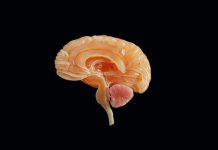
In a new study, researchers found that exposure to light flickering at a specific frequency could reduce the amyloid plaques in the brain seen Alzheimer’s disease.
The finding may help develop a new method to help control the disease.
The research was conducted by MIT neuroscientists.
Previous research from the team has shown that this method could reduce the amyloid plaques in mice.
The light flickering was presented at a frequency of 40 Hertz.
This could induce brain waves known as gamma oscillations in the visual cortex.
These brain waves are believed to contribute to attention and memory, which are impaired in Alzheimer’s patients.
In the current study, the team found that combining the flickering light with sound stimuli—40-hertz tones—could reduce plaques even further.
This new treatment has widespread effects at the cellular level.
Moreover, the treatment helps not just neurons but also immune cells called microglia.
These effects could reduce inflammation, improve synaptic function, and protect against cell death in mice.
The researchers suggest that neurodegeneration is largely prevented by the treatment.
In addition, they found the flickering light boosted cognitive function such as spatial memory.
The team suggests that their new findings may help develop better treatments for Alzheimer’s disease.
In the future, they plan to test the treatment in mice with more advanced symptoms, to see if neuronal degeneration can be reversed after it begins.
They have also begun clinical studies of light and sound stimulation in human patients.
The senior author of the study is Li-Huei Tsai, the director of MIT’s Picower Institute for Learning and Memory.
The study is published in Neuron.
Copyright © 2019 Knowridge Science Report. All rights reserved.



